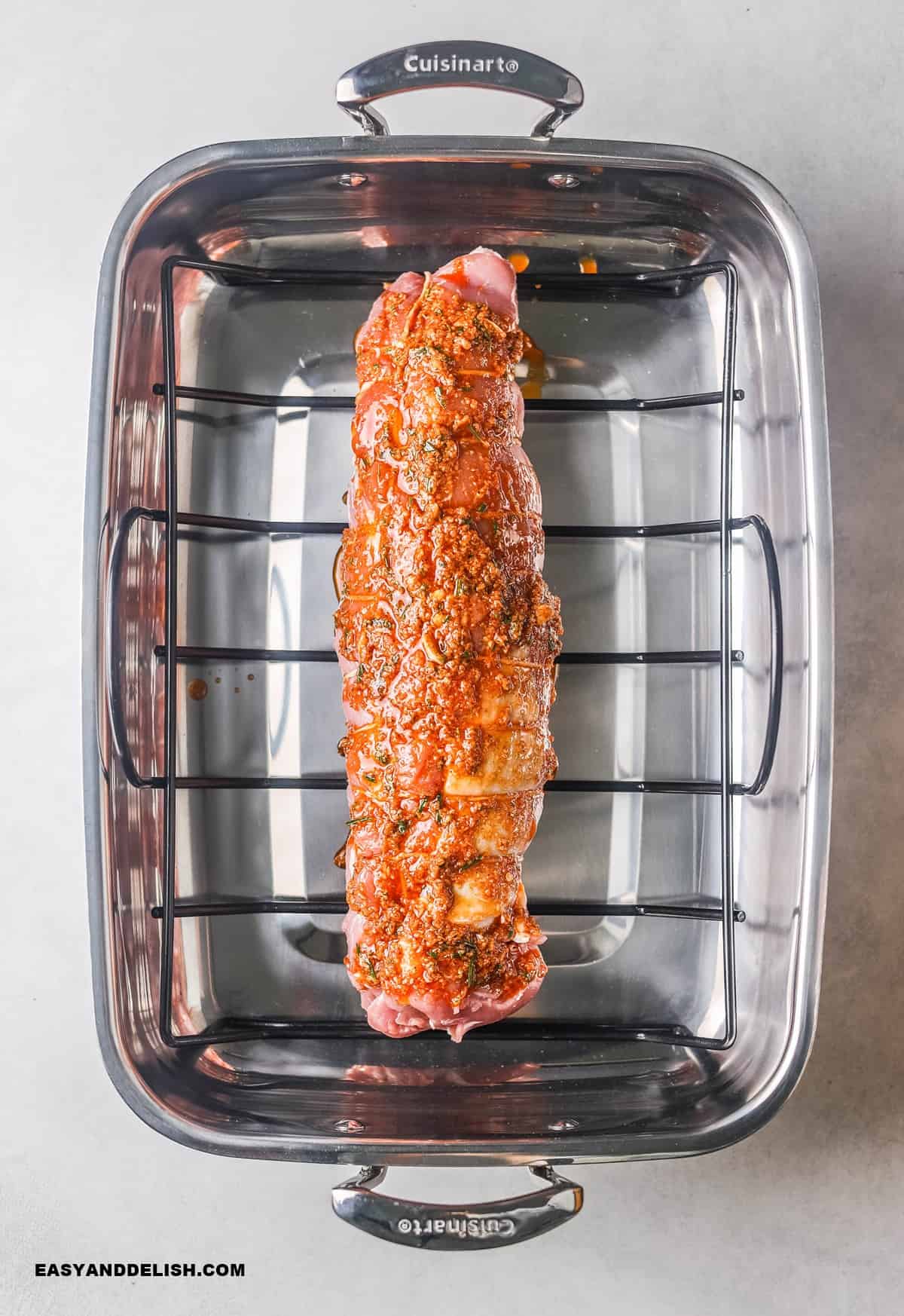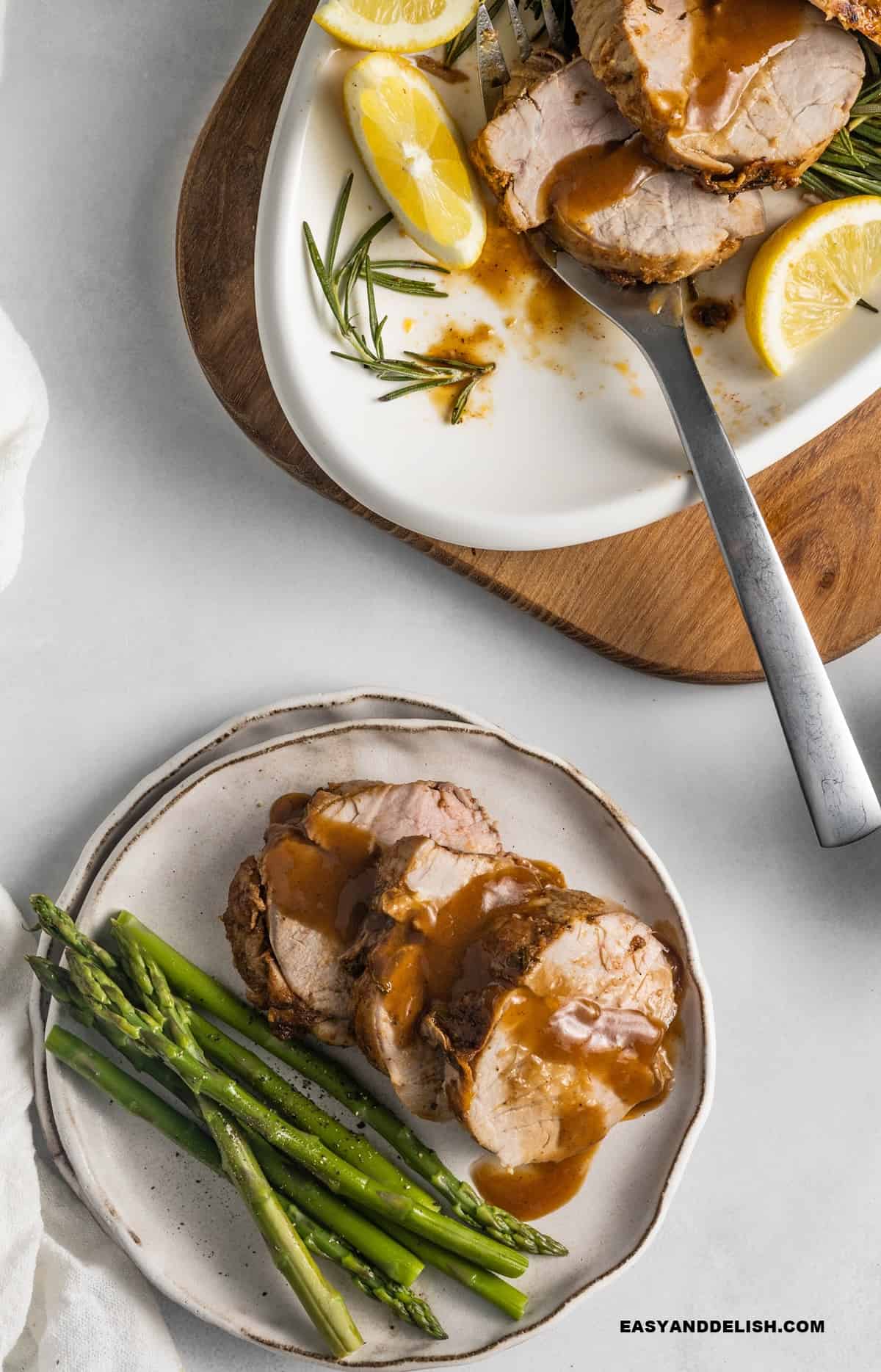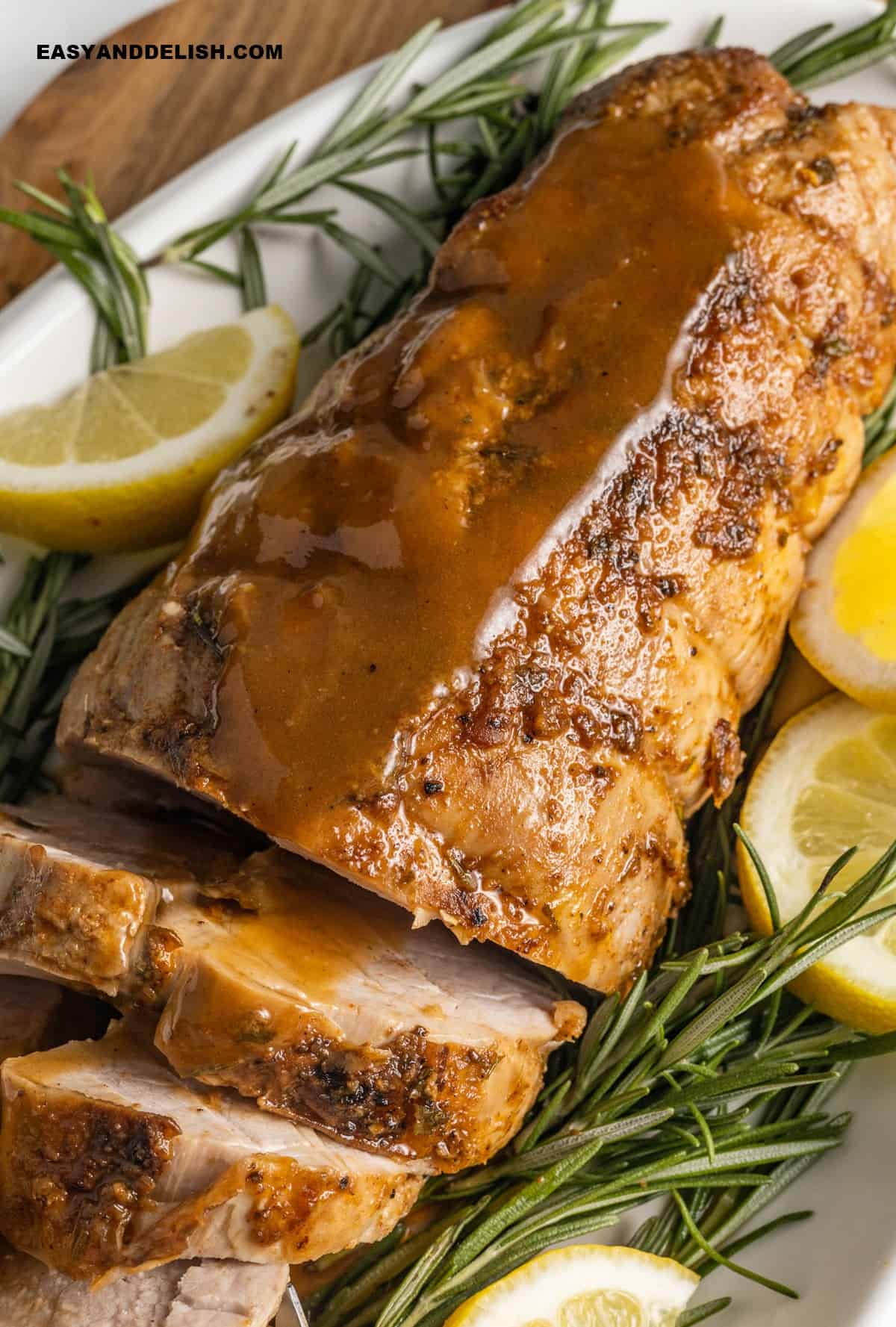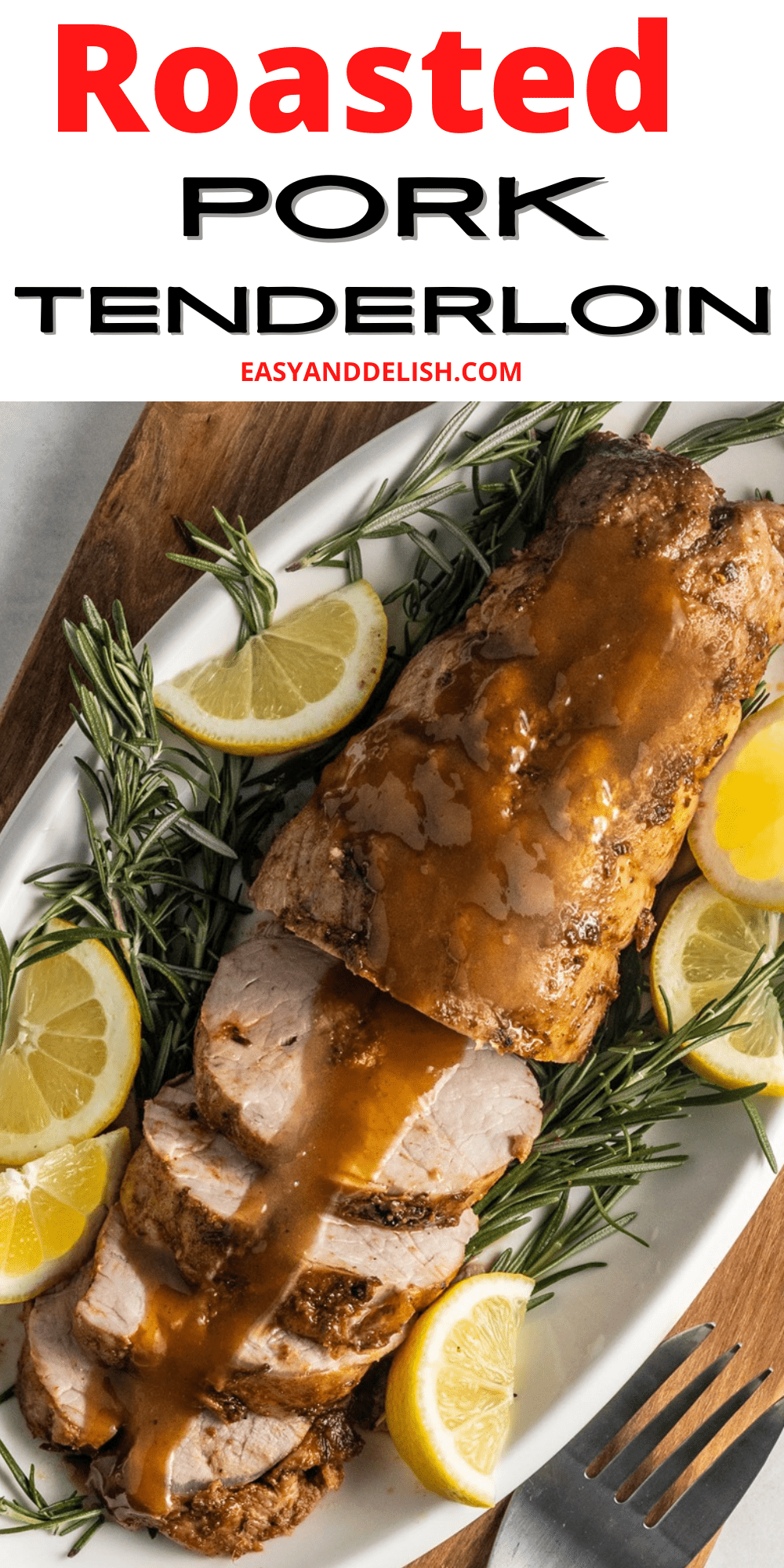Find out how to cook Smithfield pork tenderloin in the oven and for how long to come tender and juicy. It's a restaurant-quality dinner meal that is easy to make at home and perfect for any occasion!

Let's prepare together the best pork tenderloin ever... in the oven! It is easy and comes out tender and yummy!
It's one of those easy dinner ideas you want to make again and again!
Table of Contents
- 1 Why you'll love this pork tenderloin recipe
- 2 Pork tenderloin in the oven
- 3 Ingredients and substitutions
- 4 How to cook Smithfield pork tenderloin in the oven
- 5 How long to cook pork tenderloin in oven
- 6 Useful tips for making roasted pork tenderloin
- 7 What to serve with baked pork tenderloin
- 8 FAQ's
- 9 Storage
- 10 Variations
- 11 Other pork recipes to enjoy
- 12 How to Cook Smithfield Pork Tenderloin (And How Long)
Why you'll love this pork tenderloin recipe
- Succulent: This garlic pork tenderloin is roasted to golden-brown perfection in the oven, leaving you with a tender, moist, and juicy texture.
- Versatile: Oven-baked pork tenderloin is easily adaptable to suit your taste or the seasoning ingredients you have on hand.
- Elegant: The nice presentation makes this pork tenderloin ideal for special occasions, but it’s also great for casual weeknight meals!
- Healthy: It is low-carb, high-protein, gluten-free, and dairy-free.
Pork tenderloin in the oven
Originating in the United States, Smithfield pork tenderloin has become a popular choice due to its mouthwatering taste and superior quality.
With its lean, tender texture, this cut of pork is perfect for roasting in the oven. Plus, it’s a relatively budget-friendly protein option, especially for the quality you receive.
The garlic-herb paste enhances the natural flavors of the pork, while the white wine sauce adds a touch of brightness.
Once finished, the tenderloin turns out crispy and brown on the outside, but the interior remains very tender and juicy.
By learning how to cook pork tenderloin in the oven, you’ll find the flavors have a chance to fully develop and the meat cooks evenly.
Try serving this oven-baked pork tenderloin with a side of steamed asparagus and potatoes for a dish that will surely impress any crowd!
Ingredients and substitutions
For the pork loin:
- ¼ cup vegetable oil - Substitute vegetable oil with avocado oil or canola oil.
- 6 garlic cloves - Replace it with minced garlic from a jar in a pinch.
- 1 teaspoon Knorr chicken bouillon powder - Or, use a cube of chicken bouillon.
- 1 teaspoon salt
- ½ teaspoon ground black pepper
- ¾ teaspoon smoked paprika - You can also use hot, sweet, or regular paprika.
- 2 tsp fresh rosemary or 1 teaspoon dried - Alternatively, try other herbs like thyme or sage.
- 2 ½ pounds boneless pork tenderloin (I used Smithfield All Natural Fresh Pork Tenderloin – 2 count), remove any silver skin. NOTE: The package comes with 2 tenderloins, weighing a total of 2 ½ to 3 pounds.
- Fresh rosemary sprigs to decorate - Or, whichever fresh herb you use in the recipe.
- Fresh lemon to decorate - You can also experiment with other citrus fruits.

For the white wine sauce:
- ½ cup dry white wine - Choose options like pinot grigio (or pinot grigio), sauvignon blanc, or pinot blanc. You can also use unoaked chardonnay.
- ½ cup chicken broth - Homemade or store-bought chicken broth both work. You can also use vegetable broth.
- ¼ tsp salt
- ¼ tsp white ground pepper
- ½ tablespoon cornstarch, whisked with 1-2 tablespoon water until smooth - Or, use potato starch. If you're on a keto diet, use ½ tablespoon xanthan gum instead.

How to cook Smithfield pork tenderloin in the oven
Prepare the Smithfield pork tenderloin:
1. Remove the pork from the refrigerator about 15 minutes before roasting to bring it to room temperature.
2. Position a rack in the middle of the oven and preheat the oven to 400° F (about 200º C).
3. Trim away and discard the silver skin from the tenderloins. Use a paring knife, and firmly score crisscross lines that are about ⅛-inch deep and ¼-inch apart on the "flat" side of each tenderloin. Do not skip this step; otherwise, your tenderloins won’t bond together and can fall apart when you slice after roasting and resting. Make sure to pat dry each tenderloin with a paper tower!!!

4. Then place the flat sides together head-to-tail (thick end to thin end) so the overall circumference is more even and the tenderloins cook more evenly. Tie with butcher's string (not too tightly), spacing the ties 1 ½ inches apart. See Instructions on the NOTES!!!

5. In a blender or food processor, blend or process together the oil, garlic, bouillon, salt, pepper, paprika, and rosemary.

6. Place pork tenderloin, fat side up, on a rack set over a roasting pan. Spread garlic paste all over the tenderloin loin.

7. Roast in the oven until a meat thermometer inserted into the thickest part of the tenderloin registers 145°F, about 20-30 minutes, depending on the thickness of the tenderloin.

8. Remove from the oven, transfer the pork to a platter, cut the strings, and discard. Keep it warm, tented with foil, while making the wine sauce.
9. Slice the roasted pork tenderloin after resting for 5-10 minutes or just before serving.
For the wine sauce:
Pour the white wine into the roasting pan (rack removed) in which the tenderloin was cooked. Place pan over medium heat, and scrape up browned bits from its bottom.
- Add stock, salt, and pepper; then, bring to a simmer. Cook, stirring, until the liquid has reduced to half. Skim fat from the surface of the liquid.
- Strain the sauce and place it into a clean saucepan. Whisk in the cornstarch mixture and cook over medium heat until the sauce has thickened.

4. Serve it hot in a side bowl with the sliced Smithfield pork tenderloin. Garnish the loin with some chopped rosemary on the top, and also with some rosemary sprigs and sliced lemon on the side. Steamed asparagus makes a great light side for this roasted tenderloin!
A step-by-step guide to tying a 2-piece pork tenderloin:
Place the 2 pork tenderloins together on a cutting board with their fatty side facing outward.
Loop one end of the kitchen twine around the roast about 1 inch from the side and tie it in a simple knot. The size of the twine will depend on the thickness of the tenderloins and also how you twine your tenderloins.
Place the remaining string over about 1 ½ inches; hold it into place with one hand while putting it under and around the roast in a parallel loop using the other hand. When the loop is complete, thread the string through the loop and pull over another 1 ½ inches. (There will be 2 loops around the roast with a perpendicular line connecting them).
- Flip over the roast and run the string around the back side, winding around each original loop and pulling tight.
- Return the roast to its original position and tie off at the first knot. Cut off excess string.
- Alternatively, you can twine each part of the loin individually, keeping a 1 to 1 ½ inch space between them! Leave 1 inch free at each end of the tenderloins.
How long to cook pork tenderloin in oven
The cooking time varies depending on the oven temperature, the thickness of the tenderloin, the weight, and whether it was seared before roasting. Generally, it takes about 20-30 minutes at 400°F. This is all the more reason to use a meat thermometer to ensure perfect doneness (145° F).
Useful tips for making roasted pork tenderloin

Room temperature: Bring the pork tenderloin to room temperature before roasting it for a more even cook.
- Trim first: Trim away the silver skin for the most tender result.
- Score the pork: Don’t forget to score the tenderloins to help them bind together and prevent them from falling apart once they’re sliced.
- Use a tie: Tie the tenderloins together with the butcher's string to ensure they cook evenly.
Thermometer: Use a meat thermometer to check for the correct internal temperature. For pork, it should reach an internal temperature of 145°F.
Rest: Allow the pork tenderloin to rest for at least 5-10 minutes before slicing it so the juices have time to redistribute.
Deglaze: Deglazing the roasting pan with white wine creates a much more flavorful and complex base for the sauce.
- Strain: Strain the sauce and thicken it with a cornstarch slurry for a smooth texture.
- Garnish: For an aromatic and elegant presentation, don’t forget to garnish your baked pork tenderloin with fresh rosemary sprigs and slices of lemon.
What to serve with baked pork tenderloin
Once your Smithfield pork tenderloin has rested, serve it with some side dishes like these:

Garlic mashed potatoes
- Roasted carrots and parsnips
FAQ's
What are the differences between Smithfield pork loin vs. pork tenderloin?
Despite their close names, pork loin and pork tenderloin are two different cuts of meat that come from separate parts of the pig. The pork loin comes from the back of the pig, specifically the area between the shoulder and the start of the leg. Tenderloin is a small, elongated cut that’s found under the backbone and runs alongside the ribs. Pork tenderloin is more tender than pork loin (hence the name), which makes it more delicate and succulent. The loin is dense and firm in comparison. For these reasons, pork tenderloin is often more expensive than loin, on a per-pound basis.
What is the best way to cook Smithfield pork tenderloin?
It’s best to roast Smithfield pork tenderloin in the oven for a few reasons:
Even cooking: Cooking oven-baked tenderloin at a high temperature ensures even heat distribution so the meat roasts uniformly.
Flavor development: As the tenderloin roasts, the surface caramelizes and envelopes a rich brown crust, adding to its flavor.
Moisture retention: Since tenderloin is a leaner cut of meat, it can dry out easily if it’s overcooked. High heat for a shorter period helps lock in the meat's juices, getting a moist and tender result.
What is the proper internal temperature for pork tenderloin?
According to the USDA, The internal temperature for roasted pork tenderloin is 145°F for medium doneness, measured with a meat thermometer. To use a meat thermometer properly, insert the probe into the thickest part of the tenderloin, ensuring it’s inserted lengthwise. Start checking around 5-10 minutes before the cooking time of this recipe. Once it reaches 145°F, remove it from the oven and let it rest for 5-10 minutes, tented with foil.

Is it better to cook pork tenderloin at 350°F or 400°F?
Cooking at 400°F allows the baked pork tenderloin to develop a nice crust on the outside while still remaining tender on the inside, yielding more flavor. However, you can cook it at 350°F, which may result in a more even cook, but you won’t achieve the same crust. Ultimately, it’s personal preference, but pork tenderloin is typically cooked at 400°F.
Should roasted pork tenderloin be cooked fast or slow?
Roasted pork tenderloin is best cooked at a higher temperature for a shorter period, letting the outside to brown while the inside remains tender and juicy. This is why 400°F is the most common temperature to cook pork tenderloin at.
Is it better to sear pork tenderloin before baking?
Searing the pork tenderloin before baking can help develop a tasty crust, but it is not necessary for this recipe.
Storage
If you have leftover garlic pork tenderloin, follow these storage and reheating tips:
Fridge: Once fully cooled, store the leftover pork tenderloin in an airtight container for up to 3-4 days in the fridge.
- Freezer: You can freeze cooked and cooled pork tenderloin in a freezer-safe container for up to 3 months.
- Reheating: To reheat, place the tenderloin in the oven at 325°F until warmed through. Be careful not to overcook it as it will dry out the meat.
Variations
Tangy: Add Dijon mustard to the garlic-herb paste for a tangy twist.
- Herbs: Substitute fresh thyme or sage for the rosemary.
- Glaze: Drizzle a balsamic glaze on the finished dish for added sweetness and depth.
- Spice rub: Use a dry rub with spices like chili powder, cumin, and paprika.
- Bacon wrapped: Wrap the pork tenderloin in bacon before roasting it for added flavor and moisture.
Other pork recipes to enjoy
- Blackstone pork chops
- Stuffed pork loin recipe
- Crock pot pork loin
- Barbecue pork chops
- Broiled pork chops
- Barbecue pork ribs
- Baked pork ribs
- Chinese barbecue ribs
- Pork fajitas
- Grilled baby back ribs
- Stovetop baby back ribs
- Instant Pot pulled pork
- Slow cooker pork stroganoff
- Pan-seared pork chops
- Pressure cooker sweet and sour pork
PIN & ENJOY!

How to Cook Smithfield Pork Tenderloin (And How Long)
Equipment
- 1 roasting pan with rack
- 1 saucepan
- 1 whisk
- 1 cutting board
- 1 butcher's knife
Ingredients
For the pork tenderloin:
- ¼ cup vegetable oil or canola oil or avocado oil
- 6 garlic cloves
- 1 teaspoon Knorr chicken bouillon powder or a cube of chicken bouillon
- 1 teaspoon salt
- ½ teaspoon ground black pepper
- ¾ teaspoon smoked paprika or sweet paprika
- 2 teaspoon fresh rosemary or 1 teaspoon dried
- 2 ½ pounds boneless pork tenderloin I used Smithfield All Natural Fresh Pork Tenderloin – 2 count, remove any silver skin. NOTE: The package comes with 2 tenderloins, weighing a total of 2 ½ to 3 pounds.
- Fresh rosemary sprigs to decorate
- Fresh lemon to decorate
For the white wine sauce:
- ½ cup dry white wine NOTE: All the alcohol content will evaporate!
- ½ cup chicken broth or chicken stock
- ¼ teaspoon salt
- ¼ teaspoon white ground pepper
- ½ tablespoon cornstarch whisked with 1-2 tablespoon water until smooth. Or you can use potato starch! If you are on a KETO diet, use ½ tablespoon xanthan gum instead.
Instructions
Prepare the Smithfield pork tenderloin:
- Remove the pork from the refrigerator about 15 minutes before roasting to bring it to room temperature.
- Position a rack in the middle of the oven and preheat the oven to 400° F (about 200º C).
- Trim away and discard the silver skin from the tenderloins. Use a paring knife, firmly score crisscross lines that are about ⅛-inch deep and ¼-inch apart on the "flat" side of each tenderloin. Do not skip this step; otherwise your tenderloins won’t bond together and can fall apart when you slice after roasting and resting. Make sure to pat dry each tenderloin with a paper tower!!!
- Then place the flat sides together head-to-tail (thick end to thin end) so the overall circumference is more even and the tenderloins cook more evenly. Tie with butcher's string (not too tightly), spacing the ties 1 ½-inch apart. See Instructions on the NOTES!!!
- In a blender or food processor, blend or process together the oil, garlic, the bouillon, salt, pepper, paprika, and rosemary. Place pork tenderloin, fat side up, on a rack set over a roasting pan. Spread garlic paste all over the terderloin loin.
- Roast in the oven until a meat thermometer inserted into the thickest part of the ternderloin registers 145°F, about 20-30 minutes, depending on the thickness of the tenderloin.
- Remove from the oven, transfer the pork to a platter, cut the strings and discard. Keep it warm, tented with a foil, while making the wine sauce.
- Slice the roasted pork tenderloin after resting for 5-10 minutes or just before serving.
For the wine sauce:
- Pour the white wine into the roasting pan (rack removed) in which the tenderloin was cooked. Place pan over medium heat, and scrape up browned bits from its bottom.
- Add stock, salt, and pepper; then, bring to a simmer. Cook, stirring, until liquid has reduced to half. Skim fat from surface of the liquid.
- Strain the sauce and place it into a clean saucepan. Whisk in the cornstarch mixture and cook over medium heat until the sauce has thickened. Serve it hot in a side bowl with the sliced Smithfield pork tenderloin.
- Garnish the loin with some chopped rosemary on the top, and also with some rosemary sprigs and sliced lemon on the side. Steamed asparagus makes a great light side for this roasted tenderloin!
Recipe Video

Recipe Notes
- Fridge: Once fully cooled, store the leftover pork tenderloin in an airtight container for up to 3-4 days in the refrigerator.
- Freezer: You can freeze cooked and cooled pork tenderloin in a freezer-safe container for up to 3 months.
- Reheating: To reheat, place the tenderloin in the oven at 325°F until warmed through. Be careful not to overcook it as it will dry out the meat.
- Place the 2 pork tenderloins together on a cutting board with their fatty side facing outward.
- Loop one end of the kitchen twine around the roast about 1 inch from the side and tie it in a simple knot. The size of the twine will depend on the thickness of the tenderloins and also how you twine your tenderloins.
- Place the remaining string over about 1 ½ inches; hold it into place with one hand while putting it under and around the roast in a parallel loop using the other hand. When the loop is complete, thread the string through the loop and pull over another 1 ½ inches. (There will be 2 loops around the roast with a perpendicular line connecting them).
- Flip over the roast and run the string around the back side, winding around each original loop and pulling tight.
- Return the roast to its original position and tie off at the first knot. Cut off excess string.
- Alternatively, you can twine each part of the loin individually, keeping a 1 to 1 ½ inch space between them! Leave 1 inch free at each end of the tenderloins.
Nutrition
** Nutrition labels on easyanddelish.com are for educational purposes only. This info is provided as a courtesy and is only an estimate, since the nutrition content of recipes can vary based on ingredient brand or source, portion sizes, recipe changes/variations, and other factors. We suggest making your own calculations using your preferred calculator, based on which ingredients you use, or consulting with a registered dietitian to determine nutritional values more precisely.
Please note that health-focused and diet information provided on easyanddelish.com is for educational purposes and does not constitute medical advice, nor is it intended to diagnose, treat, cure, or prevent disease. Consult with your doctor or other qualified health professional prior to initiating any significant change in your diet or exercise regimen, or for any other issue necessitating medical advice.
This post was first published on February 24, 2012.









Jill says
I love pork loin...this looks so good! Do I need a special kind of pan to cook it in, or can I just use a pyrex?
Denise Browning says
Jill, thanks for your comment! I do appreciate...
You can use a pyrex. Just make sure that it's made of tempered glass (it means that can go to the oven without shattering). But you have to know that it will take longer to cook. I advice you to lay down aluminum foil on the bottom of the pyrex for easier cleanup (no stuck on grease that is hard to clean off). I roasted mine in an aluminum baking pan. Anyway, as soon as it reaches 155 F, please remove the loin from oven.